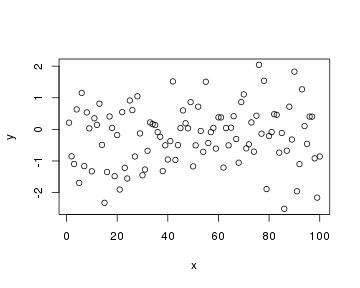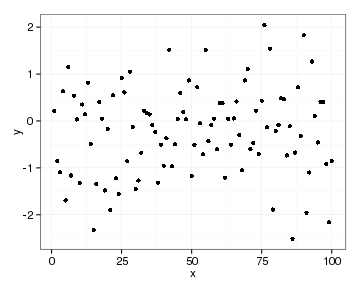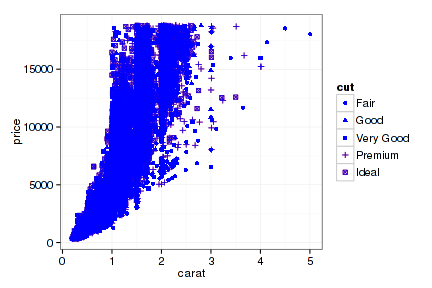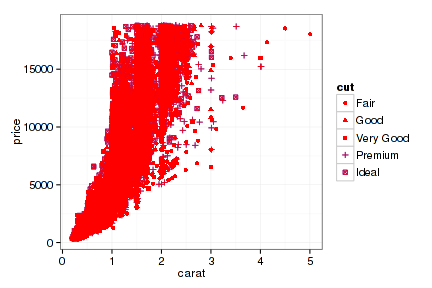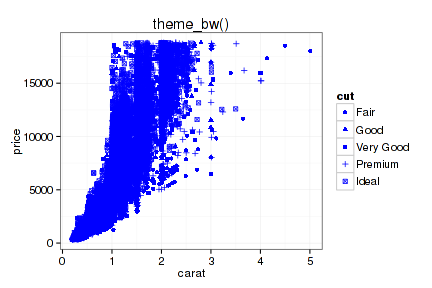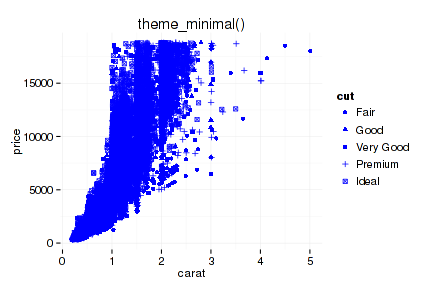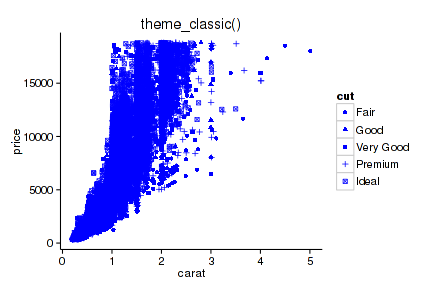前面我们使用qplot函数对ggplot2做图的方法进行了初步的了解,并比较了qplot和plot函数的用法。从最终得到的结果(图形)来看,除了外观不同外好像qplot函数和plot函数并没有什么本质的差别。这其实是一个骗局!
1 图形对象
我们知道,R语言基本做图方法都是通过函数完成的(如果不了解请参考本博客《散点图》一文),这些函数直接在输出设备上执行一些列操作得到图形。很多函数没有返回值,即使有返回值也不会反映绘图操作的整个过程。但ggplot2不一样,它用图形对象存储做图的细节,通过输出图形对象获得图形。一行一行地运行下面代码可以发现这一点:
- library(ggplot2)
- theme_set(theme_bw())
- x <- 1:100
- y <- rnorm(100)
- p1 <- plot(x, y)
- p2 <- qplot(x, y)
很显然执行最后一行代码不会得到想要的图形。下面再看看 p1 和 p2 分别是什么:
- class(p1)
- ## [1] "NULL"
- class(p2)
- ## [1] "gg" "ggplot"
- typeof(p2)
- ## [1] "list"
- str(p2)
- ## List of 9
- ## $ data :'data.frame': 0 obs. of 0 variables
- ## $ layers :List of 1
- ## ..$ :Classes 'proto', 'environment'
- ## $ scales :Reference class 'Scales' [package "ggplot2"] with 1 fields
- ## ..$ scales: list()
- ## ..and 21 methods, of which 9 are possibly relevant:
- ## .. add, clone, find, get_scales, has_scale, initialize, input, n,
- ## .. non_position_scales
- ## $ mapping :List of 2
- ## ..$ x: symbol x
- ## ..$ y: symbol y
- ## $ theme : list()
- ## $ coordinates:List of 1
- ## ..$ limits:List of 2
- ## .. ..$ x: NULL
- ## .. ..$ y: NULL
- ## ..- attr(*, "class")= chr [1:2] "cartesian" "coord"
- ## $ facet :List of 1
- ## ..$ shrink: logi TRUE
- ## ..- attr(*, "class")= chr [1:2] "null" "facet"
- ## $ plot_env :
- ## $ labels :List of 2
- ## ..$ x: chr "x"
- ## ..$ y: chr "y"
- ## - attr(*, "class")= chr [1:2] "gg" "ggplot"
plot函数的返回值p1的class属性为NULL(空),而qplot函数的返回值p2的calss属性有两个“gg” 和 “ggplot”,其本质是长度为9的列表对象。打印这个对象就会得到图形:
- print(p2)
qplot函数的作用是产生一个ggplot对象,但获得ggplot对象的更一般方法是使用对象类型的同名函数ggplot。它的用法是:
- # 非运行代码
- ggplot(df, aes(x, y, <other aesthetics>))
- ggplot(df)
- ggplot()
ggplot函数用于初始化一个ggplot对象,即使不指定任何做图相关的内容,它的结构也是完整的:
- length(p2)
- ## [1] 9
- length(ggplot())
- ## [1] 9
2 ggplot图形对象组成
ggplot图形对象是由9个元素组成的列表,这点已经清楚。元素的名称为:
- names(p2)
- ## [1] "data" "layers" "scales" "mapping" "theme"
- ## [6] "coordinates" "facet" "plot_env" "labels"
但是单从图形对象的结构上没办法理解ggplot2做图的过程和细节,所以还得了解一点相关的理论。ggplot2是Wilkinson做图理论 Grammer of Graphics 的R语言实现。太高深了,不知道从哪开始,还是从ggplot图形列表对象的元素组成做一点简单了解吧。
2.1 数据 data
似乎就是数据。但是如果试图查看上面p2对象的数据:
- p2$data
- ## data frame with 0 columns and 0 rows
是空的。但如果使用qplot函数时指定了data,情况就不一样了:
- p3 <- qplot(carat, price, data=diamonds, color=cut, shape=cut)
- head(p3$data, 3)
- ## carat cut color clarity depth table price x y z
- ## 1 0.23 Ideal E SI2 61.5 55 326 3.95 3.98 2.43
- ## 2 0.21 Premium E SI1 59.8 61 326 3.89 3.84 2.31
- ## 3 0.23 Good E VS1 56.9 65 327 4.05 4.07 2.31
- nrow(p3$data)
- ## [1] 53940
列表对象的data元素存储了整个diamnods数据框的数据。用ggplot函数可以单独指定data项:
- p4 <- ggplot(diamonds)
- head(p4$data, 3)
- ## carat cut color clarity depth table price x y z
- ## 1 0.23 Ideal E SI2 61.5 55 326 3.95 3.98 2.43
- ## 2 0.21 Premium E SI1 59.8 61 326 3.89 3.84 2.31
- ## 3 0.23 Good E VS1 56.9 65 327 4.05 4.07 2.31
2.2 映射 mapping
ggplot对象的data项存储了整个数据框的内容,而“映射”则确定如何使用这些数据。在ggplot2中,图形的可视属性如形状、颜色、透明度等称为美学属性(或艺术属性),确定数据与美学属性之间对应关系的过程称为映射,通常使用aes函数完成(qplot函数中使用参数设置映射):
- str(p3$mapping)
- ## List of 4
- ## $ colour: symbol cut
- ## $ shape : symbol cut
- ## $ x : symbol carat
- ## $ y : symbol price
- str(p4$mapping)
- ## list()
- p4 <- p4 + aes(x=carat, y=price, color=color, shape=cut)
- str(p4$mapping)
- ## List of 4
- ## $ x : symbol carat
- ## $ y : symbol price
- ## $ colour: symbol color
- ## $ shape : symbol cut
- p4 <- p4 + aes(x=carat, y=price, color=cut, shape=cut)
- str(p4$mapping)
- ## List of 4
- ## $ x : symbol carat
- ## $ y : symbol price
- ## $ colour: symbol cut
- ## $ shape : symbol cut
需要说明的是,上面第三行代码使用了加号,这是ggplot2为ggplot对象定义的运算方法,表示设置ggplot对象中对应的内容。
2.3 图层 layers
2.3.1 图层组成
在ggplot的列表结构里面看不到我们指定的图形类型参数。这些设置被分派到layers里面了:
- p3$layers
- ## [[1]]
- ## geom_point:
- ## stat_identity:
- ## position_identity: (width = NULL, height = NULL)
一个图层包含了至少3个东西(数据和映射当然必需,另算):geom、stat和position
- 几何类型 geom:是数据在图上的展示形式,即点、线、面等。在ggplot2里面有很多预定义的几何类型。
- 统计类型 stat:是对数据所应用的统计类型/方法。上面的p2和p3对象我们并没有指定统计类型,但是自动获得了identity,因为ggplot2为每一种几何类型指定了一种默认的统计类型,反之亦然。所以如果仅指定geom或stat中的一个,另外一个会自动获取。
- 位置 position:几何对象在图像上的位置调整,这也有默认设定。
不指定几何类型或统计类型的ggplot对象的图层是空列表,即没有图层,也不能输出图像:
- p4$layers
- ## list()
- print(p4)
- ## Error: No layers in plot
也就是说,指定了几何类型或统计类型,图层就会产生:
- (p4 + geom_point())$layers
- ## [[1]]
- ## geom_point: na.rm = FALSE
- ## stat_identity:
- ## position_identity: (width = NULL, height = NULL)
- (p4 + stat_identity())$layers
- ## [[1]]
- ## geom_point:
- ## stat_identity: width = NULL, height = NULL
- ## position_identity: (width = NULL, height = NULL)
为什么图层说“至少”包含3个内容呢?如果你把整个图层的内容转成列表结构显示以下就会发现更多:
- as.list((p4 + geom_point())$layers[[1]])
- ## $mapping
- ## NULL
- ##
- ## $geom_params
- ## $geom_params$na.rm
- ## [1] FALSE
- ##
- ##
- ## $stat_params
- ## named list()
- ##
- ## $stat
- ## stat_identity:
- ##
- ## $inherit.aes
- ## [1] TRUE
- ##
- ## $geom
- ## geom_point:
- ##
- ## $position
- ## position_identity: (width = NULL, height = NULL)
- ##
- ## $subset
- ## NULL
- ##
- ## $data
- ## list()
- ## attr(,"class")
- ## [1] "waiver"
- ##
- ## $show_guide
- ## [1] NA
2.3.2 图层加法
从图层的结构可以看到它在ggplot对象中是一个多重列表,如果对ggplot对象做图层加法运算,是增加图层而不是替换图层:
- (p4 + geom_point() + geom_line())$layers
- ## [[1]]
- ## geom_point: na.rm = FALSE
- ## stat_identity:
- ## position_identity: (width = NULL, height = NULL)
- ##
- ## [[2]]
- ## geom_line:
- ## stat_identity:
- ## position_identity: (width = NULL, height = NULL)
2.3.3 图层顺序
ggplot2按“层”做图,所以图层的顺序对于图形的表现会有影响,如果几何对象有叠加,那么后面图层的对象会覆盖前面图层的对象。下面只是调换了两个图层的顺序,但由于数据点是相同的,所以图形的颜色完全不一样:
- p4 + geom_point(color="red") + geom_point(color="blue")
- p4 + geom_point(color="blue") + geom_point(color="red")
2.4 标尺 scales
这是ggplot2中比较复杂的一个概念,从ggplot对象中能获取的信息不多:
- p4$scales
- ## Reference class object of class "Scales"
- ## Field "scales":
- ## list()
在ggplot2中,一个标尺就是一个函数,它使用一系列参数将我们的数据(如钻石价格、克拉)转成计算机能够识别的数据(如像素、颜色值),然后展示在图像上。使用标尺对数据进行处理的过程称为缩放(scaling)。坐标的产生和图形美学属性的处理都需要使用标尺对数据进行缩放。这个过程比较复杂,尤其是美学属性与数据的关联,因为和美学属性相关的数据不仅有连续型还有离散型,多组数据之间还要相互关照。但这些过程我们都可以不管,ggplot2也替我们做了。
标尺是函数,它的反函数用于产生坐标刻度标签和图表的图例等,这样我们才能把图形外观、位置等信息和数据对应起来。
2.5 坐标 coordinates
这都知道,用于确定采用的坐标系统和坐标轴的范围。
- str(p4$coordinates)
- ## List of 1
- ## $ limits:List of 2
- ## ..$ x: NULL
- ## ..$ y: NULL
- ## - attr(*, "class")= chr [1:2] "cartesian" "coord"
2.6 主题 theme
标题文字(字体、字号、颜色)、图形边框和底纹等跟数据无关的一些图形元素的设置都可以归到“主题”这一类。ggplot2提供了4个成套主题:theme_gray(), theme_bw() , theme_minimal() 和 theme_classic()。其中theme_gray()为默认主题,灰背景;后两个是0.9.3版才增加的。
- p5 <- p4 + geom_point(color="blue")
- p5 + theme_gray() + ggtitle("theme_gray()")
- p5 + theme_bw() + ggtitle("theme_bw()")
- p5 + theme_minimal() + ggtitle("theme_minimal()")
- p5 + theme_classic() + ggtitle("theme_classic()")
2.7 分面 facet:
一页多图,跟图层好像没有直接关系。以后再说。
2.8 标签 labels:
- str(p4$labels)
- ## List of 4
- ## $ x : chr "carat"
- ## $ y : chr "price"
- ## $ colour: chr "cut"
- ## $ shape : chr "cut"
3 ggplot2做图过程
如果E文水平可以,下载 Hadley Wickham 写的《ggplot2: Elegant Graphics for Data Analysis》一书来看看(到处都有)。理论性太强,太高深,不敢乱说。
4 SessionInfo
- sessionInfo()
- ## R version 3.1.0 (2014-04-10)
- ## Platform: x86_64-pc-linux-gnu (64-bit)
- ##
- ## locale:
- ## [1] LC_CTYPE=zh_CN.UTF-8 LC_NUMERIC=C
- ## [3] LC_TIME=zh_CN.UTF-8 LC_COLLATE=zh_CN.UTF-8
- ## [5] LC_MONETARY=zh_CN.UTF-8 LC_MESSAGES=zh_CN.UTF-8
- ## [7] LC_PAPER=zh_CN.UTF-8 LC_NAME=C
- ## [9] LC_ADDRESS=C LC_TELEPHONE=C
- ## [11] LC_MEASUREMENT=zh_CN.UTF-8 LC_IDENTIFICATION=C
- ##
- ## attached base packages:
- ## [1] tcltk stats graphics grDevices utils datasets methods
- ## [8] base
- ##
- ## other attached packages:
- ## [1] ggplot2_0.9.3.1 zblog_0.1.0 knitr_1.5
- ##
- ## loaded via a namespace (and not attached):
- ## [1] colorspace_1.2-4 digest_0.6.4 evaluate_0.5.3 formatR_0.10
- ## [5] grid_3.1.0 gtable_0.1.2 highr_0.3 labeling_0.2
- ## [9] MASS_7.3-31 munsell_0.4.2 plyr_1.8.1 proto_0.3-10
- ## [13] Rcpp_0.11.1 reshape2_1.2.2 scales_0.2.4 stringr_0.6.2
- ## [17] tools_3.1.0
原文来自:http://blog.csdn.net/u014801157/article/details/24372503



